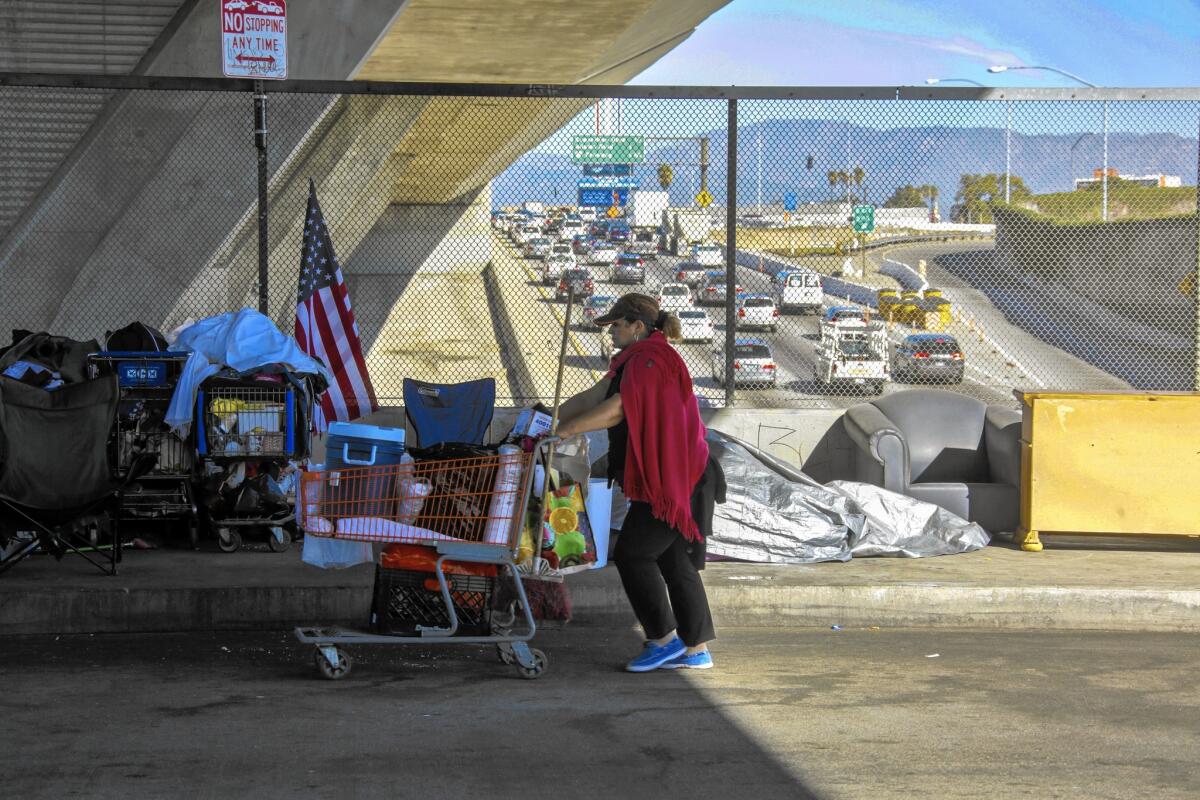L.A. tops nation in chronic homeless population

A homeless woman walks the 42nd Street bridge over the 110 Freeway in Los Angeles. The city and county have the nation’s largest population of chronically homeless people, a federal study has found.
- Share via
Los Angeles city and county have the most chronically homeless people in the country, and nearly all of them sleep on the streets, according to figures released Thursday by the U.S. Housing and Urban Development Department.
L.A.’s chronically homeless population has grown 55%, to 12,536, since 2013, accounting for almost 15% of all people in that category, HUD reported. More than one-third of the nation’s chronically homeless live in California, the agency added.
L.A.’s spike outpaced New York City’s one-year increase, the second largest, 3 to 1, the report said. The number of chronically homeless people nationwide remained basically flat, rising 1%, the report said.
“We have a long way to go,” HUD Secretary Julian Castro said during a conference call with reporters.
The spread of long-term homelessness in L.A. County has alarmed communities from Sylmar to San Pedro, where residents complain that their quality of life is threatened by crime and trash from unsightly encampments.
“I have found out that my homeless neighbors can move in and set up their shelters on the sidewalk outside of my house,” San Pedro resident Elaine Jenkins told the City Council during a hearing this week on the homeless crisis. “They can drag up old mattresses, sofas and spread trash everywhere. They can use the streets as their public restroom.”
The nationwide numbers came as a disappointment to HUD, which had extended a goal of ending chronic homelessness from the end of the year to 2017.
“We are aggressively pursuing every tool, including actively engaging our state and federal partners, to help save lives with El Niño on the horizon,” Mayor Eric Garcetti said in a statement.
The government classifies disabled people who go without housing for a year, or who land in the street several times over three years, as chronically homeless. These individuals are the most vulnerable and visible among the ranks of the homeless. They are also the most expensive and the most difficult to dislodge.
Some bounce back and forth between ambulance trips, hospital jailings or mental health confinements. Outreach workers can spend months coaxing them out of the street life to which they have adapted, and counseling, substance abuse treatment and case management can be required for months or even years to keep them in housing.
The HUD data was largely derived from a street count conducted over three days last January. Castro and U.S. Department of Veterans Affairs Secretary Robert A. McDonald joined Garcetti in taking part in the skid row count. Los Angeles city and county figures exclude statistics from Pasadena, Long Beach and Glendale, which administer their homeless programs separately.
Castro blamed the agency’s failure to reach its target on rising rents and federal funding cutbacks.
“The U.S. is experiencing an affordable housing crisis and shrinking federal budgets,” Castro said. “These resource constraints have slowed down the progress.”
Mike Neely, a commissioner with the Los Angeles Homeless Services Authority, said the city had fallen behind on building affordable housing.
“We’re working very hard to get these units developed, but man,” Neely said. “Who is taking up all the units are the millennials, the middle-class and upper middle-class individuals.”
The City Council this week declared a shelter crisis, and laid plans for expanding its winter shelter program and for authorizing people who live in their cars and RVs to sleep in church parking lots.
Garcetti ruled out an immediate declaration of a state of emergency, which some council members had sought. Garcetti said he was waiting for more information from the city attorney.
Subject to council approval, an emergency declaration would empower the mayor to requisition resources and issue orders that he deems “necessary for the protection of life and property,” according to a report from City Atty. Mike Feuer’s office. The city twice declared emergencies in the 1980s to provide shelter to homeless people.
The mayor could also call on the governor and the president to issue emergency proclamations for Los Angeles, but officials said that requesting more state and federal funding to address the homeless problem was a long shot. The city attorney said his office had not found one instance of a presidential declaration in response to a “chronic, ongoing situation such as the homeless crisis.”
ALSO
Why fewer Mexicans are leaving their homeland for the U.S.
STD cases reaching all-time highs in U.S., California and L.A. County
Mystery deepens for burning SUV with 3 bodies: 2 men died of gunshots, police say
More to Read
Sign up for Essential California
The most important California stories and recommendations in your inbox every morning.
You may occasionally receive promotional content from the Los Angeles Times.











